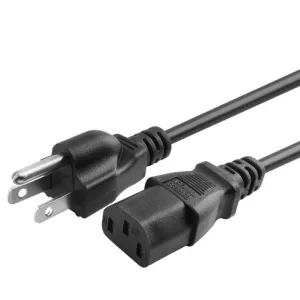
PC Cable Essentials: To Build and Maintain Your PC
December 12 2023 
Inquiry
Global electronic component supplier AMPHEO PTY LTD: Rich inventory for one-stop shopping. Inquire easily, and receive fast, customized solutions and quotes.
QUICK RFQ
ADD TO RFQ LIST
In this blog, we will demystify the world of PC cables, providing you with all the information you need to build and maintain your PC with confidence.
What is a PC Cable?
A PC cable is a specific kind of cable that is used to link a PC to additional devices or accessories. These cables make it easier for data, power, and audio/video signals to be transferred between the computer and external devices. USB cables, Ethernet cables, display cables (including HDMI, DisplayPort, DVI, and VGA cables), power cables, audio cables, and other cables used to connect peripherals to a PC, such as printers, external hard drives, and audio devices, are common types of PC cables. PC cables are necessary to connect a computer to external devices, allowing power supply, communication, and data transfer.
Types of PC Cables
- Power Cables: These are the most important cables, as they provide power to your motherboard, CPU, graphics card, and other components. The most common types are:
- ATX 24-pin: Links the motherboard and power supply unit (PSU).
- EPS 8-pin/12-pin: Provides the CPU with extra power.
- PCIe 6+2-pin: Graphics card power is provided by PCIe 6+2-pin.
- SATA: Gives storage drives power and data.
- Data Cables: These transmit information between different components:
- SATA: This interface links the motherboard to storage drives (SSDs and HDDs).
- USB: Used to connect a wide range of accessories, including external drives, keyboards, and mice.
- Front Panel Headers: Attach the motherboard to the case's USB ports, LEDs, and reset and power buttons.
- Audio Cables: These carry audio signals:
- HD Audio: Attaches the motherboard to the front panel audio ports.
- Internal audio connectors: Attach the motherboard's audio outputs to the speakers or headphones inside.
What Cables are Needed for a PC?
The specific cables you need will depend on your PC configuration. However, some essential cables are required for every PC:- ATX 24-pin: Provides power to the motherboard.
- EPS 8-pin/12-pin: Depending on the CPU model, this pin provides extra power to the CPU.
- PCIe 6+2-pin: When using a dedicated GPU, the PCIe 6+2-pin provides power to the graphics card.
- SATA: Storage drives (SSDs and HDDs) are connected via SATA.
- USB: For attaching devices such as mice and keyboards.
- Front Panel Headers: Attach the USB ports, LEDs, and reset and power buttons on the casing to the motherboard.
Where to Buy PC Cables?
PC cables can be purchased from various online retailers and electronics stores. Some popular options include:- Amazon: Provides a large selection of cables at affordable costs.
- Newegg: Another well-known internet merchant offering an extensive assortment of PC parts.
- Microcenter: A physical store with a decent assortment of cables that specializes in computer hardware.
- Local electronics stores: A small assortment of PC cables is available at several stores, such as Best Buy and Fry's Electronics.
What are PC Cable extensions?
PC cable extensions are extra cable lengths used to increase the reach of the built-in cables in a computer configuration. These extensions are made to attach to the ends of current cables, thereby increasing the cable's overall length. They are frequently used to handle circumstances in which the original cables are too short to reach the intended location or in which cable management calls for more flexible or longer routing. There are PC cable extensions available for a variety of cable types, such as power, HDMI, USB, audio, and more. They are made to often meet the specifications of the original cables they are intended to extend and are available in various lengths. A USB cable extension, for instance, could be plugged into an existing USB cable to extend its reach. It would have a USB connector on one end and a USB receptacle on the other. In custom PC builds, where cable management and aesthetics are crucial, these extensions are especially helpful. They can aid in the creation of a neater and more organized setup by providing greater flexibility when it comes to cable routing. They can also be utilized to increase the range of peripherals, displays, and other PC-connected devices, giving computer system components more flexibility in how they are arranged.Are PC Cable extensions safe?
In general, when PC cable extensions are used correctly and of high quality, they are safe to use. It's crucial to use reliable manufacturers of high-quality cable extensions and to confirm that the devices and cables they are meant to extend are compatible with the extensions. Important procedures for guaranteeing safety include observing the manufacturer's usage instructions, avoiding excessive bending or pulling on the cables, and routinely checking them for wear or damage. To prevent electrical hazards, make sure power cable extensions are rated for the right voltage and current before using them. You can safely increase the reach of your PC cables to meet your needs and setup by following these guidelines.Conclusion
In conclusion, creating and maintaining a functional and aesthetically pleasing PC system requires an awareness of the various PC cables, their extensions, and the best cable management techniques. In order to achieve the best possible performance, dependability, and aesthetics in their computer builds, PC enthusiasts should choose the appropriate cables, use extensions when needed, and employ efficient cable management techniques. A computer system's overall functionality and appearance are greatly influenced by the cables that are used to power its components, transfer data, and customize its appearance.FAQs about PC Cable
What are PC Cable extensions? PC cable extensions are longer versions of standard cables that allow for better cable routing and aesthetics. They lengthen the length by plugging into existing connectors, but use them carefully because they may have negative effects. How do I organize PC cables? You can neaten and arrange your PC cables with the use of cable ties, Velcro straps, and specialized cable management products. This enhances maintenance, airflow, and aesthetics. Can I use any USB cable for my PC? For simple data transfer, most USB cables are functional. On the other hand, make sure the cable is USB 3.0 or later and supports the necessary bandwidth for high-speed data transfer or charging devices. How often should I replace my PC cables? PC cables have a long lifespan if they are not damaged. To prevent future problems, check them frequently for wear and tear and replace them if they become frayed or damaged.Related Articles
- ·Stratix 10 VS Stratix V: Which FPGA is Right for Your Next Project?
- ·Intel Xeon Platinum 8454H vs AMD EPYC: Which Reigns Supreme?
- ·A Deep Dive into the AMD EPYC 4564P Processor
- ·MSP430F5438A vs MSP430F5529: A Detailed Analysis of Their Capabilities
- ·Comparing MSP430F6659 and MSP430F5419A: Which One is Right for Your Project?
- ·Exploring the Features of MSP430F5529 and MSP430F5638 Microcontrollers
- ·Demystifying 20 Microcontroller Projects for Beginners
- ·Unveiling the Ultimate Guide to Microcontroller Programming
- ·4680 Battery: Unveiling the Power Potential of the Next-Gen Cell
- ·Exploring the Case Studies on Arduino Applications
Populer Posts
SAF7755HN/N207WK
NXP Semiconductors
E7111-0-102A19-AG
onsemi
CS497024-DVZR
Cirrus Logic Inc.
AD21489WBCPZ202
Analog Devices Inc.
TMS320TCI6486CCTZL
Texas Instruments
ADSP-21060LAB-160
Analog Devices Inc.
AD21478WYCPZ1A02
Analog Devices Inc.
ADSP-SC589BBCZ-5B
Analog Devices Inc.
DSPIC33CK256MP706T-I/MR
Microchip Technology
SAF7758HV/N205ZY
NXP Semiconductors
ADSP-2186LKSTZ-133
Analog Devices Inc.
TMS32C6205DGWTA200
Texas Instruments
